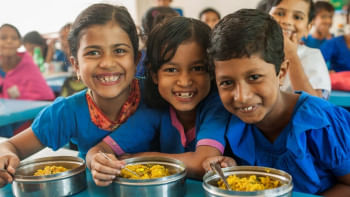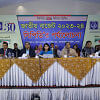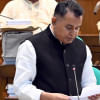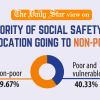Rethinking Bangladesh's social security budget

It is budget season in Bangladesh. All the ministries have submitted their demands to the finance division (FD). The FD is balancing those against the supply of resources. And social security is an important component of the expenditure side of the budget, and is supposed to cater mainly to the poorer segment of citizens.
I was recently invited as a designated discussant to a seminar on "How to improve coverage and effectiveness of the Social Safety Net Programmes?: Findings from a primary survey", organised by the Centre for Policy Dialogue (CPD) and Christian Aid (CA). Based on a recently conducted survey of 436 households across Bangladesh, they found the existence of high exclusion (that is, exclusion of deserving beneficiaries from the social security list), inclusion errors (inclusion of non-deserving beneficiaries in the social security list), and leakages from the system.
The findings on the prevalence of high exclusion and inclusion errors as well as leakages are not surprising, but depressing and unfortunate. If we accept the findings (based on a rather small sample), the conclusion is that the system has made little progress since 2015. The year 2015 is considered a game-changer for the social security system in Bangladesh, much thanks to the NSSS. The National Social Security System (NSSS) is a forward-looking plan to transform the existing system into a modern and inclusive one that is powered by technology to enhance welfare for poor and vulnerable citizens. While analysing the situation, the NSSS used data from the 2010 Household Income and Expenditure Survey (HIES). Almost a decade ago, the NSSS had also reported high exclusion and inclusion errors, inefficiency, and leakages. On the basis of these findings, the NSSS provided proposals to strengthen programmes and systems. It recommended establishing a single register of existing and potential beneficiaries, a robust MIS, and a grievance mechanism.
Almost a decade after the approval of the NSSS, the country has not yet established a single registry system or installed a robust MIS. The National Household Database (NHD) was carried out by the BBS with financial support from the World Bank, with the aim to prepare a comprehensive database for all households in Bangladesh. However, the fate of the NHD is still unclear five years after its inception in 2018. Even if it is made available now, the database will have lost its relevance due to demographic transitions and large income growth. Moreover, the criteria for beneficiary selection which were prepared in 2013 are still in use – raising concerns over the usefulness of these criteria due to their lack of dynamism and adaptability. In particular, the wealth criteria has become obsolete as, for example, an income threshold of Tk 10,000 per year has been used to calculate old age allowance since 2013, even though our national income has increased by about 210 percent since then.
Since the implementation of the proposed system strengthening has been slow, most surveys to assess the health of Bangladesh's social security system produce disappointing outcomes. Between March and April 2023, a pilot community-based targeting and selection process (CBTSP) was carried out in two unions in Bangladesh, under the ADB's Covid-19 Active Response and Expenditure Support (CARES) programme and with active collaboration of the Department of Social Services (DSS). Only two programmes, old age allowance and widow allowance, were considered. One of the key findings was that outdated wealth criteria alone account for about 95 percent of the inclusion errors in one of the unions. The pilot CBTSP produced encouraging outcomes which suggest that, with community involvement, it is possible to better identify beneficiaries for social security programmes (SSP). The results suggest that following the rigorous process of focused group discussions, social mapping, transect walks, and dedicated household surveys, it is possible to prepare a master beneficiary list for any and all SSPs.
Coming back to the question of horizontal and vertical expansion, what should be our stance? More specifically – given the existence of problems in the social security system – should we go for horizontal (that is, increasing beneficiary coverage) or vertical (enhancing transfer amount) expansion? My personal view is that we should not entertain either of them. Rather, the government should seriously consider the proposals that follow.
The criteria used for beneficiary selection for SSPs need a complete overhauling. As mentioned, wealth criteria (income, consumption, and land ownership) are very dynamic in Bangladesh. Hence, there is a need to not only update them but to also include provision for periodic automatic updates in line with economic expansion.
The government has been following the incremental budget for SSPs in Bangladesh. But given systemic problems, such an approach is leading to large leakages and very low value for tax revenue. Thus, the FD and line ministries must cease the incremental budget approach. They must strive to use alternative approaches based on data and evidence to prepare the social protection budget.
Since the NHD is not functional, the government must look for alternative beneficiary selection methods. The CBTSP approach may be an important source of information to prepare evidence-based social protection budgets, which is likely to improve selection, reduce leakages, and improve value for money. However, in order to assess robustness and to prepare for scaling it up at the national level, a large-scale pilot programme should be considered. This may be conducted in four upazilas across four regions – north, south, east, and west – to allow assessments and inclusion of regional characteristics.
Once the system is developed and comprehensive social and beneficiary registries are in place, the government may go for horizontal and vertical expansion of the SSPs. For horizontal expansion, the NSSS recommends covering 50 to 60 percent of the most vulnerable individuals. For vertical expansion, four to five separate transfer values may be used – linked to the assessed needs of the beneficiaries under the programmes. For instance, the transfer value for the mother and child programme must be different from the transfer values for old age allowance and widow allowance. Similarly, the government must use completely different transfer value criteria for merit programmes, such as the freedom fighter allowance.
Finally, a social security system is composed of three conventional pillars: (1) social assistance (SA); (2) social insurance (SI); and (3) active labour market programmes (ALMP). Both SI and ALMP are underdeveloped in Bangladesh. It is thus imperative to ensure balance between these three pillars to generate maximum benefits and ensure private sector participation.
Dr Bazlul H Khondker is a professor of economics, former faculty member at Dhaka University, chairman at SANEM, and director at the Policy Research Institute of Bangladesh (PRI). He can be reached at: [email protected]

 For all latest news, follow The Daily Star's Google News channel.
For all latest news, follow The Daily Star's Google News channel. 














Comments